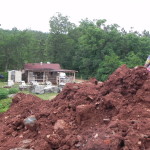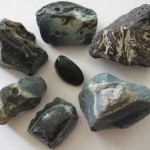by Winding Pathways | Apr 11, 2015 | Geology/Weather, Reflections/Profiles, Wonderment
At three a.m.the mind wanders many paths. Sometimes they re-join and a message emerges.
During an early morning thunderstorm awakening, I recalled an experience at the open pit mine in Arkansas digging through the muddy rubble for crystals. Small points eluded me until an experienced crystal hunter helped train my eye. A few way too large chunks unrealistically tempted me. At one point, filthy, covered head to boot heel with thick red Razorback mud, I paused and looked around.

Razorback Red soil heaped up for crystal seekers to dig through.
Four things happened in quick succession. Surveying the devastation of mining, I started to cry. As I reached down in the ruined earth to apologize to the elegant, imposing crystal in front of me, a thought as clear as a refined crystal came to me, “Mining is a vicious activity.” As if to confirm my thought, deep red blood splattered on the rock. It took a few moments for me to realize the blood was mine! I had sliced open my little finger along the length of the last phalange on a razor sharp edge of the rock.
I just stoode there watching the blood drip on the crystal and sinking into the brick colored soil. I let the bleeding go, partly from shock, partly to wash out dirt, partly as a tribute for the violence done to the earth.
When I returned to the car we cleaned off and bound the wound, which kept bleeding for hours and opened up and bled many days after. On the way home, I reflected on the raw crystals and the lovely pure white and clear refined crystals we “ohhh” and “ahhh” over and buy in stores.
Our lives are like these crystals. Sometimes we are torn from all we think we know and love. The forms of violence are endless. The list goes on and on. In the raw we are rough, stained and fairly unattractive. Refined, we can glimmer, gleam and shine – sometimes in genuine completeness. Other times if too refined, we can become phony looking because our true selves are hidden by another factor – false perfection.
As I reflected, my little finger began to ache – again. A reminder of a time when I sympathized with Mother Earth and received a scolding from her. A lesson to share.
by Winding Pathways | Nov 10, 2014 | Geology/Weather, Nature, Reflections/Profiles, Wonderment

Obsidian has one characteristic that slag generally lacks – a hint of translucence.
On our recent Antiquities Tour, Rich and I came across interesting rocks on an abandoned railroad bed in Eastern Colorado. The chunks looked like obsidian. They fractured like obsidian and had the feel of obsidian. But, they didn’t quite look right. But blue and pretty! So, we put a bunch in the car. Rich was excited.
One of my geologists colleagues confirmed my observation on the fracturing and glassy feel of the rocks. But, they didn’t have the slightly translucent look of obsidian. Still I like them. So, I gave some to friends.
One scientist friend, Linda Mueller, appreciated the rock and investigated further. Here is our conversation on FB.
“I’ve been asking around about the rock you gave me. The consensus seems to be that the colors indicate that it’s slag glass and not obsidian. Certain areas in Colorado use it as railroad ballast. Obsidian and glass slag are so similar that it’s often difficult the tell the difference. Unscrupulous ebay sellers have taken advantage of this and have sold the artificial form as the real thing.
“Anyhow, whatever it is, I’m still fascinated by it. It’s beautiful and it will remain on my desk as a paperweight. Thank you again for it.”
I replied, “Thanks for checking this out!”
Linda added, “I was hoping for something interesting like turquoise. Still the stone is calming in a odd sort of way. It’s cool to the touch and smooth among the rough (parts).”
My thought: “Maybe good energy can come from slag. Say, that might be a good blog! Help me write it?”
So Linda did the work!
Linda: “I think so. The rock is truly entrancing. I can’t explain it. From the moment I saw it, I was fascinated by it. It was a special gift. I truly mean that.
“When you think about it, it does look a lot like obsidian, which is volcanic glass. I can’t remember what you said the spiritual properties of obsidian are but I wonder if they mirror the history of the stone? A huge amount of geothermal energy is needed to create obsidian. It flows from a volcano, then cools and solidifies. Tension moving toward calm? (Great analogy, I thought!)
“Glass slag is similar to obsidian; it, too, consists mainly of silica dioxide. It’s formed by heating ores (rock) to high temperatures. It’s a human-made rock, but it’s not a new technique. Humans have been creating it since the late bronze age (1500 – 1000 BCE). At least three thousand years! Wow! Ancient man found other uses for the leftover glass slag. They recycled it even then. Somehow we lost sight of that when technology gave us easier ways to make glass and pottery. Now we’ve come full circle and have found uses for it again.
“Might glass slag have properties similar to obsidian since the two are so similar? When I hold the rock, I feel calm. It takes away tension. The coolness and the weight of the stone is comfortable. Like obsidian, it was formed from heat/molten rock (tension) and it’s present state is cool/solid rock (calm).
“When you think about it, it fits. You and I have a strong interest in preservation, recycling, taking care of the earth. The rock cries out:
“‘Hey, look at the beauty and usefulness I have! Quit taking rocks from the earth to crush for railroad ballast when you already have me. I was needed for another purpose and now that it is complete, I’m moving on to my next one.’
“Everyone I’ve shown it to has had positive reactions to it. I wonder why that is?”
So, our on-line conversation ended here. But perhaps readers can weigh in and add to this. Obsidian or Slag – What Does it Matter?
The gift had the intention of love, perhaps that is a clue.


